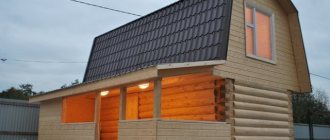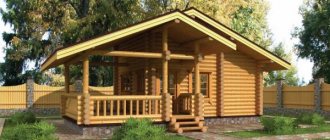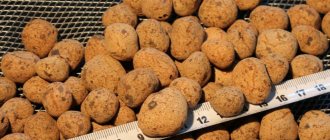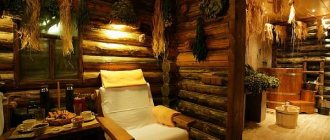Photo from the site https://domik.ua
The stove was and remains the heart of the Russian bath. But the methods of heating a steam room have undergone changes over time, which has made the task easier for novice bathhouse attendants. At the same time, the traditional wood-burning stove remains to this day. This method is not easy and requires knowledge and experience.
In this article we will tell you how to properly heat a Russian bathhouse with wood.
Types of firewood
Even if the heating system includes gas or coal-fired equipment, it is impossible to completely do without firewood. Some connoisseurs of comfort and coziness have a fireplace at home. And to maintain health there is one good and proven remedy - a bath!
But, returning to the question of which firewood is best for a stove, bathhouse or fireplace, it is worth knowing about their varieties. The amount of heat released during combustion depends on how dense and hard the logs are. Knowing which firewood is more efficient for heating a home, you can significantly save on fuel.
People have been using wood for a long time to make fire, which has served various purposes since ancient times: it gave warmth, helped cook food, and scared away uninvited guests. Some trees burn better, producing a lot of heat, while others are poorly suited for heating and emit soot during the combustion process. For this reason, there are types of firewood that are ideal for heating a house or lighting a bathhouse. Others are better placed in the fireplace.
The most popular tree species are:
- conifers (pine, spruce, larch);
- birch;
- alder;
- oak;
- fruit;
- Linden;
- aspen;
- willow.
All firewood is different, and it’s not that some types are better than all others. Each of them has advantages and disadvantages. Let's look at them in more detail, but first a few words about the calorific value of firewood from different types of wood.
Primary requirements
The best firewood for heating stoves is dry. Humidity should be within 20%. This is the main requirement. The calorific value of wood depends very much on its moisture content.
Dry wood flares up and burns well, emits more heat, and smokes less. The logs should not be rotten or saturated with water. Water logs are not suitable for heating stoves.
Good firewood leaves little ash. It is advisable to harvest wood in late autumn or winter, when sap flow stops and the wood is denser.
The size of firewood for the stove depends on the size of the firebox, usually 35-40 centimeters long. The thickness is medium, thick logs split. Small logs are easy to light. They also burn quickly, which must be taken into account when preparing them.
A couple of phrases about calorific value
In terms of its chemical composition, wood is a rather complex material. It contains the main components - lignin and cellulose. But besides them, the tree contains:
- resins;
- proteins;
- tannins and other ingredients.
When logs burn in a stove (or simply when trees burn in a forest), these components interact with the air at a chemical level. The calorific value of wood (as well as any fuel), or thermal conductivity, is the amount of thermal energy that a unit of weight of the fuel material (in our case, 1 kg of wood) produces during combustion. Kilocalories are used to measure quantities.
The chemical composition among most tree varieties has minimal variations, which causes differences in the number of calories emitted. That is, the heat of combustion of some types of firewood can be as follows:
- for deciduous species the figure is 4460 kcal/kg;
- for coniferous species - 4560 kcal/kg;
- for mixed breeds – 4510 kcal/kg.
As you can see, the differences are minimal. At the same time, it is easy to understand that it is better to use coniferous wood for the stove due to its greater thermal conductivity. Only firewood is supplied to the market depending on volume, not weight. That is, the main criterion for choosing firewood is cubic meters. Density plays an important role here, because the higher it is, the heavier the wood.
For example, let’s take 1 cubic meter of birch logs as a starting point. Then the ratio of the volume of different rocks will look like this:
- oak logs - 0.75 cubic meters. m;
- alder logs - 1.1 cubic meters. m;
- pine logs - 1.2 cubic meters. m;
- spruce logs - 1.3 cubic meters. m;
- aspen logs - 1.5 cubic meters. m.
That is, 1 cubic meter of birch and 0.75 cubic meters. m of oak logs, 1.1 cubic meters. m of alder wood (and so on) will produce the same amount of heat. Knowing this, now, depending on how much firewood costs, you can get profitable savings for yourself.
Coal
Coal is of natural, not man-made origin. In some regions of Russia, coal is mined, which is enough not only to supply the domestic market, but also for sale abroad.
Good to know: How to properly heat a stove with coal, basic rules
But coal is divided into several types, which differ in the age of its formation. It is not difficult to guess that higher quality rocks differ in the duration of their occurrence in the layers. There are three types of coal classification, although the same grades are involved in each.
- Classification by formation time. In this division, four types of coal are distinguished: lignite, brown and hard coal, and anthracite coal. These breeds are listed in order of increasing age. They also differ in physical properties. Lignite is presented in the form of crumbs, since it is not able to hold its shape. Brown coal is also not very durable, but it can already be used in home stoves. Although its calorific value is far from its analogues. Hard coal is the most common and accessible type, and anthracite is considered the highest quality rock.
- Classification by humidity and content of volatile compounds. In this gradation, known rocks follow the same sequence. Their humidity decreases from 40% to 5%. A similar picture emerges with volatile substances. In this division, anthracite occupies an advantageous position.
- Classification by calorific value. We had to introduce the calorific value parameters earlier, so it makes no sense to duplicate the indicators. It should only be emphasized that this classification is decisive when choosing fuel for a home stove.
Softwood firewood: pine, spruce, larch
By the characteristic crackling of the logs, which literally caresses the ear, and the bright scattering sparks, you can determine the combustion of pine logs. They give off a lot of heat, but burn out quite quickly. But many shortcomings are quickly forgotten thanks to the unique resinous aroma that comes from burning pine or spruce firewood. Only in this case you should be extremely vigilant, since sparks shooting out from time to time can cause a lot of trouble. Therefore, it is necessary to observe safety precautions.
It is worth noting that pine logs produce more heat than spruce logs. Largely due to the high content of resinous substances, due to which the above-mentioned aroma is released. Pine and spruce, it produces an equally invigorating effect. In addition, it can have a tonic effect on the organs of the upper respiratory tract. In addition, spruce logs have a “shooting” effect, while pine firewood has a smoke effect. But the wood of both species splits and melts easily, although it smokes heavily.
As for larch, rarely does anyone light a firebox with such wood due to its low prevalence. It should be taken into account that when logs burn, carbon monoxide is released in large quantities. For this reason, you should not immediately close the damper, and your country house or country cottage should have high-quality ventilation.
Alternative fuel materials
The calorific value of certain types of firewood is quite high, but far from the maximum possible. In order to save money and space for storing heating material, today more and more attention is being paid to alternative options. It is optimal to use pressed briquettes.
The efficiency of using briquettes is several times higher than that of firewood
For the same oven load, pressed wood produces much more heat. This effect is possible by increasing the density of the material. In addition, there is a much lower percentage of humidity. Another plus is minimal ash formation.
Briquettes and pellets are made from sawdust and wood chips. By pressing waste, it is possible to create an incredibly dense combustion material that even the best types of wood cannot compare with. With a higher cost per cubic meter of briquettes, the final savings can amount to a very significant amount.
It is necessary to prepare and purchase combustion materials based on a thorough analysis of their properties. Only high-quality firewood can provide you with the necessary heat without causing harm to your health or the heating structure itself.
Tags: firewood, property, poplar
« Previous entry
Birch - traditions should not be broken
Most people are inclined to believe that such firewood is the best fuel for starting a fire in a fireplace, stove or sauna. And all due to invaluable advantages:
- easy to light;
- burn for a long time;
- the flame turns out beautiful and even;
- no sparks;
- copious heat generation.
But the advantages don't end there. Since ancient times, the healing properties of birch have been known. The pleasant aroma has a beneficial effect on the human body, protecting it from colds and chronic diseases. In other words, birch firewood has a disinfecting effect, which causes approval among those who like to take a steam bath.
When burning, logs emit a small amount of carbon dioxide, and this is certainly a plus. But there is also a minus - a high concentration of tar. And this combustion product is no longer beneficial to health. In addition, soot and soot form on the walls of the stove and in the chimney. As a result, over time, not only is traction lost, but the risk of fire or carbon monoxide poisoning increases. Therefore, when choosing this firewood, it is also worth mastering the profession of a chimney sweep, as well as maintaining safety.
But, despite its shortcomings, birch is the most popular, cheapest and most practical fuel.
Secrets of lighting a stove
Many people tend to mistakenly evaluate fuel by the ease of its ignition. It will not be possible to light coal without firewood; in addition, the ignition process itself must be carried out correctly. This contributes to a long service life of the stove.
The stove must be inspected externally every time you intend to light it. Substances or objects that are easily flammable and were accidentally placed nearby are first removed to a sufficient distance. Before kindling, the chamber and ash pan must be cleaned, removing unburned food. To prevent small particles of ash from flying around the room, it is recommended to pour a little water into the ash pan.
Household waste containing plastic or bitumen cannot be used for kindling, as they cause the formation of large amounts of soot in the chimney. The firebox door and the ash pan should not be open in pairs. This rule is useful, since when kindling you have to adjust the draft.
Coal is usually stored indoors, but moisture may not be excluded. In this case, it must first be dried. When wet coal is burned, all the water in the form of steam goes up the chimney. A large amount of soot settles on the wet surfaces of the pipe walls.
Crumpled old newspapers are placed on the grate. Small wood chips can be placed on top of them. Wood logs are stacked in a hut or a well, depending on your habits. After this, we light the stove by closing the firebox door and opening the ash pan.
When the firewood begins to burn out and the first hot firebrands form, you can add a portion of small coal, after which larger pieces are gradually added. When burning coal, you should close the chimney damper, this will save heat. But remember that when the damper is closed, there is a high probability of filling the room with carbon monoxide. Watch the flame, a blue tint indicates that it’s time to open the damper.
Alder - a royal gift
If you want to feel like a member of the royal family, you should get hold of some alder logs, because it’s not for nothing that they are popularly called royal logs. They flare up quickly, emit a huge amount of heat, and produce virtually no smoke, which also eliminates the appearance of soot and soot. In addition, logs burn for a very long time. That is, the question of what kind of wood is best to heat the stove in the house has already been resolved!
But the main highlight is the unique aroma, which has a healing effect. It has long been accepted that if you heat a bathhouse using alder wood, you can forget about colds once and for all. Moreover, even in ancient times, it was alder logs that were put into the royal furnaces, as well as the fireboxes of other estates of rich peasants or nobles.
A fresh cut of alder has a red-orange hue, giving the woodpile an unusual and bright appearance. However, there is one interesting feature that everyone should know about. All the benefits described apply to trees that grew in dry areas. If the plants bloomed in the swamp, then there will be soot and unbearable heat.
Alder is especially popular among those who like to smoke meat or fish. Under normal conditions, wood dries quickly, and it retains its healing natural properties for 3 years.
Features of furnaces using coal
The vast majority of real stove models that we remember from our grandparents were adapted to use wood and coal. This averaging of the design was carried out on purpose, because it was difficult to predict what would have to be used to heat the stove in each specific season. However, if you take a detailed approach to the construction of the furnace, then these options should differ.
The temperature inside the firebox when burning coal is much higher than when burning wood. This leads to the fact that the walls of the metal firebox are strengthened using thicker sheets. The volume of the firebox increases due to the lower location of the grate. The ash pit is built to be larger in volume, since the amount of ash when using coal is much greater than that of firewood.
Getting ready to light the oven
Oak - fortress of spirit
Which firewood burns longer? Of course, oak! They are characterized by high strength and density. It is no coincidence that experts jokingly classify this breed as an elite variety, and only then it is valued as a type of fuel. Due to these features, oak logs maintain heat at the required level, produce intense heat, and the negative impact of various external factors does not in any way affect them.
The aroma emanating from the firewood is so pleasant, tart and soft that you can feel the breath of the forest expanses. Like birch, oak can have a beneficial effect on the human body, in particular on the nervous system. It also promotes relaxation and strengthens the immune system.
Wood is long-lived, and finding wood suitable for kindling is not so easy. Not just any logs are suitable for this. Firewood from young plants will not produce much heat, but when old plants burn, a large amount of ash is formed, the air becomes too heavy - not every bathhouse visitor will be able to withstand it.
Heating a house with wood from middle-aged trees works well - they provide just as much heat as needed, or even more. But they are not so easy to find, so oak is rarely used as fuel, and it also grows very slowly.
For reference: once upon a time, good and strong ships were built from oak. Now it is believed that truly tasty and juicy pizza can only be cooked using oak wood. They are also ideal for lighting a fireplace, the only difficulty is that such wood is not easy to split.
Wood superstitions and beliefs
Believe it or not is up to you, but they say that...
- It is better to prepare firewood for a bath on the waning Moon; their healing power will be higher, the thinner the lunar crescent at the time of preparation;
- the ancient Slavs believed that the maple was once a man (its leaves resemble open palms, and its branches look like hands raised to the sky), so they never used maple firewood;
- In the old days in the Tambov province it was believed that on Pokrov the stove should be heated only with apple wood - so that the house would be warm all winter, even in the most severe cold.
What kind of firewood do you prefer and why?
Fruit trees for flavor
Of course, no one will specifically grow fruit trees for the sole purpose of using them for firewood. However, there is still an apple, pear, plum or cherry tree on the site. Over time, you can collect a lot of branches and twigs, which you can put into the firebox. Some people make fires right away, but it would be much more correct to carefully cut them and put them in a woodpile. They are ideal for lighting a sauna, since along with a good and even heat, the combustion of wood produces light steam accompanied by a pleasant, delicate aroma.
It costs nothing to saw and chop firewood; the apple tree is the leader in terms of heat release, and there is practically no smoke. But this choice is more of an aesthetic nature.
Storage rules
Purchased high-quality wood for heating must be properly stored, since moisture reduces the useful technical characteristics. Arranging a place does not require much effort; owners often use the material to create decorative woodpiles of various shapes. Select an area for storing firewood taking into account the following characteristics:
- a dry and elevated place is determined in the yard in which water flows to lower areas;
- stacked firewood is placed loosely so that small gaps between them provide ventilation;
- the wood storage area is covered with a canopy or roof (if this place is not in a barn) to protect it from rain and snow;
- sawn and chopped logs are not collected in a woodpile for 4-6 months after cutting the trunk from the root;
- trees harvested in summer require more time to dry;
- For ease of use, the warehouse is located near the entrance to the house - this will allow you to collect fuel in any weather conditions.
Short firewood eats up useful space, and long firewood does not allow you to close the stove door or place rings. The thickness of the logs is medium in size. The owners prepare the firewood and store it in full for the winter, so as not to have to deal with cutting in sub-zero temperatures.
Aspen – cleaning firewood
Aspen also takes a long time to light and burns out quickly. Therefore, you should not use such firewood to heat the stove, as they say, “from scratch.” At the same time, the flames are long and bright. There are also some other valuable properties. In addition to the fact that firewood itself does not form soot, it is able to remove carbon deposits formed from other logs. At the same time, when compared with birch firewood, aspen logs produce much less heat when burned.
But they can be used to “clean” the chimney. For this purpose, it is recommended to add several aspen firewood at the final stage of the firebox. And the chimney will be “cleaned”. Although they themselves do not produce heat, they are able to maintain heat for a long time.
Light willow logs
If you come across willow firewood in your field of vision, you shouldn’t refuse them. The heat from them is great, the flame is even, and in addition there is no soot. The only drawback is that they burn out too quickly. However, this can easily be compensated for if there are a sufficient number of willow trees in the area where you live. Many landscaping companies don't give them much time to develop. Old trunks are cut down, and branches are removed from still young trees. So you shouldn’t miss any opportunity to profit from such fuel for your home, bathhouse or fireplace.
Exotic
As you know, there are quite a lot of tree species, and to list all their types, you could write a thick book, or even more than one.
Therefore, in addition to the varieties listed, it is worth touching on at least a few more:
- Elm. It produces a lot of smoke, is difficult to split and takes a long time to ignite.
- Poplar. Like firewood for a stove - nothing at all. They prick easily, just scatter sparks and burn quickly.
- Beech. It is also difficult to light and split, but can be used raw.
- Fir. Like poplar, it is easy to prick and ignite, but you cannot do without a lot of smoke and sparks.
- Sycamore. Wood is easy to kindle, but difficult to split.
Can they be used for heating in a stove? Everyone can find the answer to this question themselves. But, on the other hand, why not?!
Benefits of wood fuel
Why do many people choose to light the stove with wood if this process is quite labor-intensive? Many people know firsthand that this is the most environmentally friendly and healing way to create heat in a steam room.
Professional bath attendants also note other advantages of this type of fuel, because firewood:
- do not explode, thereby providing gradual and safe heating of the room;
- are relatively inexpensive;
- burn for a long time;
- give off a lot of heat.
Photo from the site https://tourizm74.ru
An alternative to logs can be wood processing products called pellets. They are granules of compressed sawdust. This material is easy to transport, but when using sawdust for a bath procedure, it is quickly consumed.
If you still prefer wood, then it will be useful for you to know which species to choose for the firebox.
This is important to know!
Regardless of the type of trees that will be used for firewood, you need to know about some features:
- Deadlines. Of course, those logs that have already served their “allotted” time will also burn (provided that they are dry and there is no mold on them). However, most trees retain their aroma only for two years. Alder and aspen are a pleasant exception in this regard - 3 years.
- Everything has its time. In winter, the humidity of trees is at a minimum level. In this regard, the preparation of firewood must be done during this period. Drying usually takes about 12 months. However, the timing depends on the type of forest, harvesting time, storage conditions and a number of other factors. In this case, the duration may increase significantly or, conversely, decrease.
- Dimensions. Which firewood is more profitable? Of course, those with optimal sizes. And these are 40-50 cm in length and 8-10 cm in thickness. This is how they are convenient to store and are suitable for any firebox.
- Rot. Under no circumstances should you use rotten firewood. Keeping logs on the ground for a long time results in the accumulation of toxic substances released during combustion, which is not beneficial to humans. For this reason, when cutting down branches, you should immediately take the correct measures to store them. When choosing raw materials for heating among dead wood, you should not take into account long-fallen branches.
- Storage issues. Logs should be laid with the bark facing up. This will protect the firewood from accidentally entering moisture, which evaporates faster from the surface of the bark. And if you show your imagination, you can build an original woodpile to the delight and surprise of your guests.
As can be seen from this material, it is not enough to know which firewood is best for the stove. It is equally important to ensure that they are stored correctly.
Regarding the arrangement of a woodpile, you can always come up with a lot of different ideas: from the most creative and crazy to the simplest to implement.
Deciduous
Larch firewood is better suited for heating in the house. The absence of adhesive substances in them does not cause smoke. Some of these rocks are suitable for kindling.
Alder
Alder is treated as the most beautiful firewood. Alder in the cut section has a varied color shade. It depends on where the tree grows. Conveniences include the fact that you don’t need to dry it.
Oak
Very expensive firebox material to use for firewood. Oak is economical to use. It is often added to other types of firewood. Due to this, more heat is generated in the combustion chamber.
The fiber structure is more dense. This type is not suitable for lighting a stove.
Birch
Birch firewood provides 30% higher heat transfer than other varieties. They contain tar. Thanks to this, the flame flares up quickly and the heat is maintained for a long time.
Birch has its pros and cons. It is not subject to long-term storage. Logs cannot be stored for more than 2 years. There is rot inside them.
Aspen
Aspen firewood, when burned, cleans the chimney. The soot falls down from it and is then removed. They are rarely used because aspen firewood does not produce enough heat.
Poplar
Poplar firewood is used for stoves only because of its low cost. Used when there is no other fuel. They burn quickly and do not produce heat. It is better to take more expensive wood. The payoff will be higher in the long run.
Ash
Ash firewood is rarely used. This is due to the fact that they are not often found, have a very solid structure and a high price. Their good characteristics even exceed oak.
Maple
Maple firewood is rarely used for heating. Maple can be used to make furniture and musical instruments. Therefore, only its waste is used as fuel for the furnace.
Folk tales
Superstitions and beliefs circulate among the people. For example, it is believed that it is better to prepare firewood for a bath during the waning moon. Moreover, the thinner the sickle, the stronger the logs are endowed with healing powers. Once upon a time, the Slavs believed that people who left the world turned into maples in their lives. The appearance of its leaves is akin to open palms, and its branches represent hands raised to the heavens. For this reason, they never fired maple stoves.
In the old days, residents of the Tambov province heated their stoves exclusively with apple trees to keep the house warm throughout the winter, including especially frosty days. Whether to believe all this or not is everyone’s business, but what happened was what happened. What do you, dear readers, think: what kind of firewood is better for a stove, bathhouse or fireplace?
How to store it correctly?
To maintain the quality of firewood for a long time, you need to ensure proper storage. No special conditions are required for this; a number of points need to be taken into account:
- The woodpile should not be located in a low place where water can accumulate. Otherwise, the wood may rot.
- Logs should be stacked loosely to ensure good ventilation.
- To provide protection from precipitation, a canopy is made.
- There is no need to stack firewood immediately after harvesting. It's better to do this in a few months.
- It is recommended to store it near the house so that there are no difficulties with access to the woodpile.










